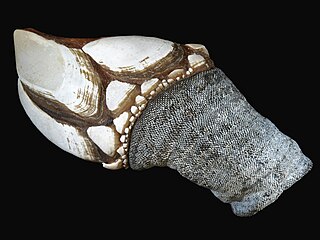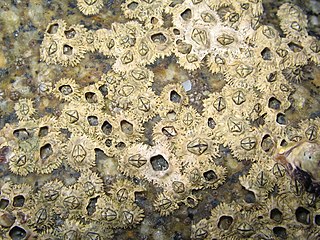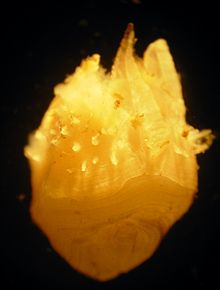
The Ren & Stimpy Show is an American animated television series created by John Kricfalusi and originally produced by Spümcø for Nickelodeon that premiered on August 11, 1991, and ended on December 16, 1996. The series follows the adventures of the title characters: Ren Höek, an emotionally unstable and sociopathic Chihuahua; and Stimpy, a good-natured yet dimwitted cat.

Goose barnacles, also called stalked barnacles or gooseneck barnacles, are filter-feeding crustaceans that live attached to hard surfaces of rocks and flotsam in the ocean intertidal zone.

Balanus is a genus of barnacles in the family Balanidae of the subphylum Crustacea.

Thoracica is a superorder of crustaceans which contains the most familiar species of barnacles found on rocky coasts, such as Semibalanus balanoides and Chthamalus stellatus. They have six well-developed limbs, and may be either stalked or sessile. The carapace is heavily calcified. The group includes free-living and commensal species.
Armatobalanus is a genus of crustacean in family Balanidae. It contains at least the following species :

Marland T. "Ren" Höek and Stimpson J. Cat, created by John Kricfalusi, are the title characters in the Nickelodeon animated series The Ren & Stimpy Show. Kricfalusi created the characters during his stay at Sheridan College and they first appeared on film in the pilot episode "Big House Blues". Ren is a scrawny, emotionally unstable and sociopathic ”Asthma Hound” Chihuahua, and Stimpy is a dim-witted, good-natured Manx cat. The show portrays their wacky, bizarre, and often surreal adventures.

Chthamalus is a genus of barnacles that is found along almost all non-boreal coasts of the northern hemisphere, as well as many regions in the southern hemisphere. These small barnacles have been studied in part because of the taxonomic confusion over a group of species that, by and large, are morphologically and ecologically quite similar. In recent years, molecular techniques have identified a number of cryptic species that have been subsequently confirmed by taxonomists using morphological measurements. Most recently the genus has been shown to be paraphyletic, with the genus Microeuraphia nested within Chthamalus.

The Archaeobalanidae are a family of barnacles of the order Sessilia.
Calantica is a genus of barnacles in the family Calanticidae, containing the following species:
Conopea is a genus of barnacle, containing the following species:

Amphibalanus is a genus of barnacle of the family Balanidae that includes species formerly assigned to Balanus. It contains the following species:
Heteralepas is a genus of goose barnacles in the family Heteralepadidae.
Paralepas is a genus of goose barnacles in the family Heteralepadidae.

Coronula is a genus of whale barnacles, containing the following species :

Poecilasmatidae is a family of goose barnacles.

The Hexanauplia constitute a class of crustaceans, comprising three groups: the Copepoda, the Tantulocarida and the Thecostraca.

Tetraclita is a genus of sessile barnacles in the family Tetraclitidae. There are more than 20 described species in Tetraclita.

Tetraclitidae is a family of sessile barnacles in the order Sessilia. There are about 10 genera and more than 60 described species in Tetraclitidae.

Scalpellidae is a family of acorn barnacles in the order Scalpellomorpha. There are more than 30 genera and 330 described species in Scalpellidae.













